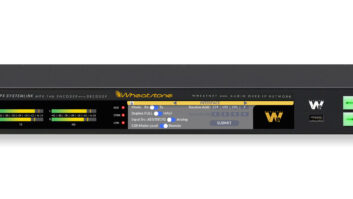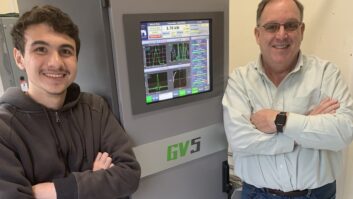The center of control
May 1, 2001 12:00 PM, By Barry Thomas, CSRE
The most critical focal point in a radio studio is the audio console. From day one, the audio console must serve several masters: The engineer wants easy installation and maintenance, high audio quality, flexibility and physical resilience. The announcers want the ease of baby’s first radio, and the ability to forget about equipment and think about their shows. Station management generally wants anything inexpensive that will keep the announcers from complaining.
While radio operations have become more streamlined, radio control rooms and production studios have become more complex. More mixes, feeds, sources and controls are needed than ever before. One reason for this is the lack of engineers who have the time or resources to build all the custom devices needed in a radio studio. We have come to expect off-the-shelf solutions to the myriad of technical challenges. Most of those solutions are best integrated with the radio operator’s primary control point: the main audio console.
Manufacturers have risen admirably to the task with a wide variety of product options and features that should satisfy almost everyone. It’s interesting that when you see an ingenious, home-made device attached to or around the console, you can expect to see a production version of that device in a manufacturer’s product line in short order. As a result of all these advances, those in a position to replace the station’s audio console or build a new studio have some great choices.
Production
Radio production has changed so remarkably over the past few years that the studios in many stations bear no resemblance to the standard on-air radio studio. The key to production studios is flexibility. Most stations have invested in digital production/editing systems and equipment so that standard broadcast consoles simply aren’t flexible enough. As a result, engineers have taken the cue from the pro sound industry and have installed recording consoles with channel equalizers, multiple sends, effects returns and other previously unknown-to-radio-console enhancements. Others have invested in mixing technology that simply augments their digital editing system, leaving the mixing tasks to computer programs and specialized hardware.
What’s available?
Mackie has a broad product line of analog mixers that have become a mainstay of radio production rooms, but it is by no means the only player. A visit to your local music store will give you an idea of the broad range of manufacturers that offer mixers � like Soundcraft, Studiomaster, Yamaha and Behringer. When planning the size of this type of mixer, don’t forget that the inputs are typically mono and that input-channel second or B inputs can be problematic. While usually easy to install, these consoles are often extremely difficult to repair. Fortunately, they are frequently priced so that replacement after a few years is not a major expense.
At the other end of the pro sound spectrum are digital production consoles. Mackie and Soundcraft have impressive digital audio consoles, but the Yamaha O2R and Panasonic DA7 have proved effective studio centerpieces. Digital mixers offer all the advantages of their analog counterparts but have the ability to save and recall scenes or mix settings, automate mixdowns, and use internal third-party processing plug-ins instead of outboard equipment for effects and dynamics processing. Digital consoles present an entirely new set of wiring conventions that most radio engineers aren’t accustomed to, but wiring a purely digital studio can be simpler than a full-featured analog room.
There are problems with using this sort of console for your production facility. Pro-sound studios and the recording-grade consoles are complicated to operate. The biggest disadvantage is the lack of control features and ease of use that a broadcast console would have. Speaker muting and warning lights are often a problem as well as equipment remote controls. If the production room serves as a standby on-air studio, it’s hard to imagine using a concert-sound audio mixer to run your station. There are add-on products that can solve many of the problems, but they aren’t ideal solutions if you want true broadcast functionality.
Fortunately, broadcast console manufacturers have taken some of the best features of the pro sound world and added them to their lines of proven products. Harris/Pacific offers the Production mixer and X-series production consoles, which are extremely flexible for stereo and multitrack production. Wheatstone also offers analog production consoles but also has the D-600/D-700 digital audio consoles, which are excellent production tools. These consoles are essentially a routing switcher with console controls and features. Just like the pro-sound digital consoles, console setups, equalization and internal processing settings can be saved as scenes so that precise settings can be duplicated.
On air
The main studio console is the bottleneck of your entire station. It must have all the features and controls to handle every eventuality, yet be so simple and easy to understand that there are no on-air mistakes. The lion’s share of development in broadcast consoles is directed to this function.
Console manufacturers have migrated to the sloped-top, slide-fader form factor. This can sometimes create a problem for operators who can’t or won’t adapt. Many engineers know of Rick Dees’ RCA console. LPB and Autogram still offer the classic audio console style and functionality in addition to the now-standard slide-fader consoles. Proven analog designs are still the basis for consoles from Radio Systems and Ward-Beck. Advances and enhancements to analog consoles continue despite the increased presence of digital equipment.
The greatest recent advances have been made in the digital arena. The industry has long been calling for a means to mix and control all of the digital sources in the studio without subjecting the audio to repeated analog-to-digital-to-analog conversions. Console manufacturers have invested an incredible amount of energy and money into developing digital technology, but the evolution of the console has still been comparatively slow. We are now to the point where the digital audio consolecan more than satisfy a broadcaster’s expectations.
Digital on-air consoles can be separated into two general types: those that follow classic broadcast console construction and function, and those that are controls for a routing switcher. The control-surface form factor of both types is similar, but the underlying architecture is vastly different.
The classic construction is a self-contained mixing system that includes analog-to-digital converters for individual analog sources and is built around a wiring architecture that is similar to its analog counterpart. These consoles have most, if not all, of the features of analog radio consoles but suffer from the same limitations of expandability and flexibility. These consoles have offered stations an easy upgrade patch to digital mixing.
Studer radio consoles, Fidelipac, and Audioarts and Wheatstone D-series consoles work on this principle. These consoles can be configured for muting and channel assignments by computer on the fly and can even control external routers, switches and automation systems using serial data.
For some time, Harris/Pacific has offered the Integrity, Impulse and Airwave Digital, and has introduced the BMX Digital console, which offers classic console design features with multiple mix and send buses.
The router-type digital console is different. All audio is connected to a completely configurable digital audio engine that is managed through a console-like control surface. This architecture lends itself to expansion and configuration options that blur the line between console and routing system.
The Arrakis digital console looks and feels like an analog console, but there is no audio inside. Instead, there is an audio engine that handles all audio inputs and outputs. The console is simply a control panel.
Auditronics, Logitek and Klotz have developed a systems approach to the audio console. Their consoles also depend on a router engine, but they are designed to be part of a greater system. These engines can be networked with multiple control surfaces attached so that studio inputs can be accessed from multiple locations.
With the router systems concept, a digital audio frame supports all inputs and outputs. These frames are linked like a network, and each studio has an appropriate control surface. These studios have the ability to control and route sources in other rooms. This networking can be extended off-site with computer networking so that studio sources can be controlled remotely over a WAN. Imagine a remote where the announcer runs his own board at the site. All the manufacturers offer a range of control surface options from small and simple to large and elaborate to manage their routing systems.
Console systems like this are ideal for complete studio build-outs but can be a challenge to integrate into an existing digital/analog facility. If a single engine and console are added, long-range planning is important to insure that the system can be expanded and integrated properly. In any digital console installation, a new set of rules must be learned. Concepts common to video or computer networking, such as clock sync, fiber-optic networking and wiring impedance, become applicable to radio facilities.
While the basic functions of the broadcast audio console are unchanged, the methods and operations have changed remarkably with industry needs and new products. Investigate all the consoles available, but make sure that it satisfies the users and their priorities. If the new console is a replacement, make a note of all of the work-arounds the current users have attached, and make sure your new choice includes these as part of its design.
Barry Thomas is president of Media Systems Design, Los Angeles.












